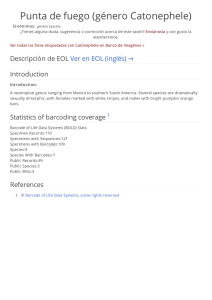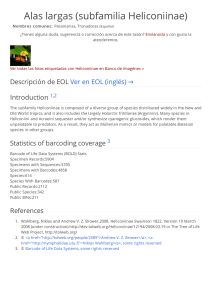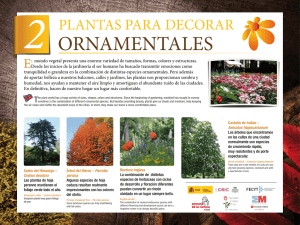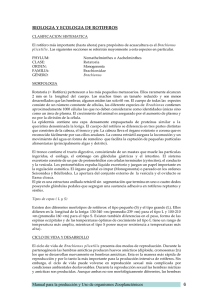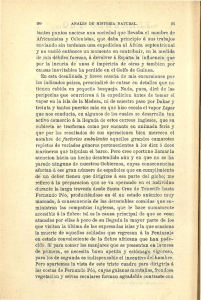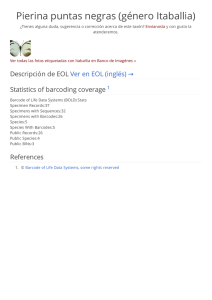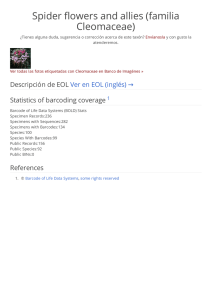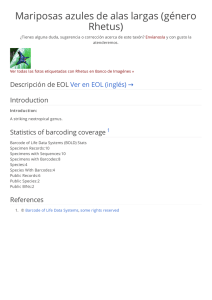On the description of Brachionus araceliaesp. nov. A new species of
Anuncio
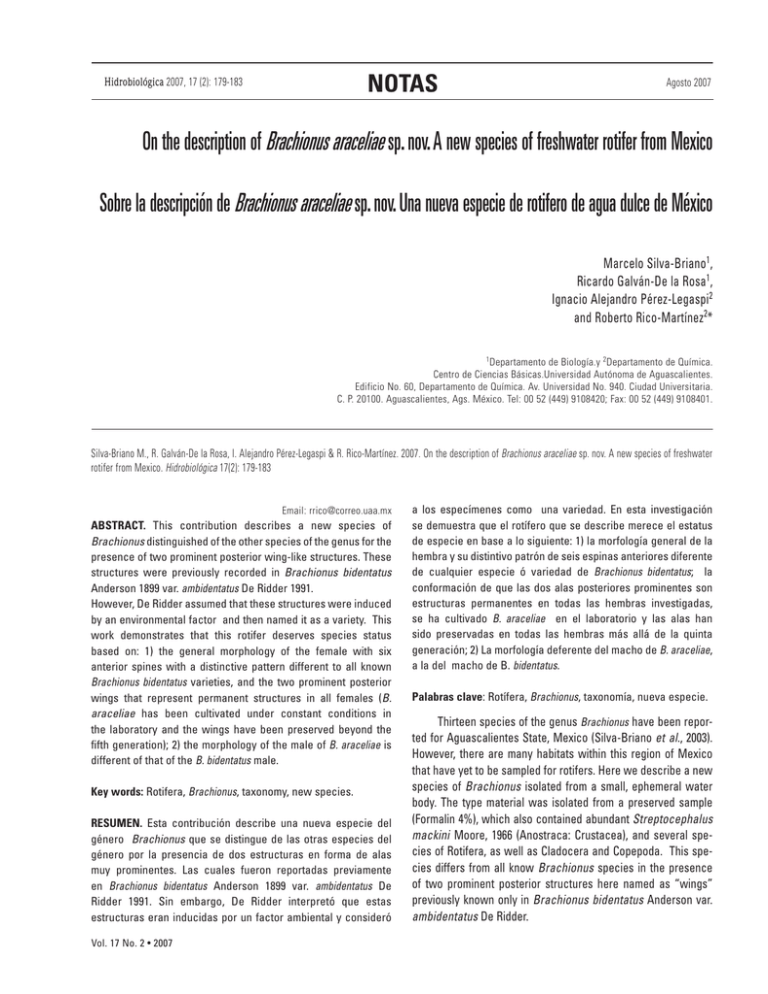
NOTAS Hidrobiológica 2007, 17 (2): 179-183 Agosto 2007 On the description of Brachionus araceliae sp. nov. A new species of freshwater rotifer from Mexico Sobre la descripción de Brachionus araceliae sp. nov. Una nueva especie de rotifero de agua dulce de México Marcelo Silva-Briano1, Ricardo Galván-De la Rosa1, Ignacio Alejandro Pérez-Legaspi2 and Roberto Rico-Martínez2* 1 Departamento de Biología.y 2Departamento de Química. Centro de Ciencias Básicas.Universidad Autónoma de Aguascalientes. Edificio No. 60, Departamento de Química. Av. Universidad No. 940. Ciudad Universitaria. C. P. 20100. Aguascalientes, Ags. México. Tel: 00 52 (449) 9108420; Fax: 00 52 (449) 9108401. Silva-Briano M., R. Galván-De la Rosa, I. Alejandro Pérez-Legaspi & R. Rico-Martínez. 2007. On the description of Brachionus araceliae sp. nov. A new species of freshwater rotifer from Mexico. Hidrobiológica 17(2): 179-183 Email: rrico@correo.uaa.mx ABSTRACT. This contribution describes a new species of Brachionus distinguished of the other species of the genus for the presence of two prominent posterior wing-like structures. These structures were previously recorded in Brachionus bidentatus Anderson 1899 var. ambidentatus De Ridder 1991. However, De Ridder assumed that these structures were induced by an environmental factor and then named it as a variety. This work demonstrates that this rotifer deserves species status based on: 1) the general morphology of the female with six anterior spines with a distinctive pattern different to all known Brachionus bidentatus varieties, and the two prominent posterior wings that represent permanent structures in all females (B. araceliae has been cultivated under constant conditions in the laboratory and the wings have been preserved beyond the fifth generation); 2) the morphology of the male of B. araceliae is different of that of the B. bidentatus male. Key words: Rotifera, Brachionus, taxonomy, new species. RESUMEN. Esta contribución describe una nueva especie del género Brachionus que se distingue de las otras especies del género por la presencia de dos estructuras en forma de alas muy prominentes. Las cuales fueron reportadas previamente en Brachionus bidentatus Anderson 1899 var. ambidentatus De Ridder 1991. Sin embargo, De Ridder interpretó que estas estructuras eran inducidas por un factor ambiental y consideró Vol. 17 No. 2 • 2007 a los especímenes como una variedad. En esta investigación se demuestra que el rotífero que se describe merece el estatus de especie en base a lo siguiente: 1) la morfología general de la hembra y su distintivo patrón de seis espinas anteriores diferente de cualquier especie ó variedad de Brachionus bidentatus; la conformación de que las dos alas posteriores prominentes son estructuras permanentes en todas las hembras investigadas, se ha cultivado B. araceliae en el laboratorio y las alas han sido preservadas en todas las hembras más allá de la quinta generación; 2) La morfología deferente del macho de B. araceliae, a la del macho de B. bidentatus. Palabras clave: Rotífera, Brachionus, taxonomía, nueva especie. Thirteen species of the genus Brachionus have been reported for Aguascalientes State, Mexico (Silva-Briano et al., 2003). However, there are many habitats within this region of Mexico that have yet to be sampled for rotifers. Here we describe a new species of Brachionus isolated from a small, ephemeral water body. The type material was isolated from a preserved sample (Formalin 4%), which also contained abundant Streptocephalus mackini Moore, 1966 (Anostraca: Crustacea), and several species of Rotifera, as well as Cladocera and Copepoda. This species differs from all know Brachionus species in the presence of two prominent posterior structures here named as “wings” previously known only in Brachionus bidentatus Anderson var. ambidentatus De Ridder. 180 Material examined: Holotype, one female mounted on one permanent glass slide with glycerine, in Gurr DEPEX one chemical standard material to seal the glass slides, and two paratypes on permanent glass slide deposited at El Colegio de la Frontera Sur (ECOSUR), Chetumal, Quintana Roo State, Mexico. Holotype (ECO‒ CHZ‒ 03015), paratype 1 (ECO-CH-Z-03016), paratype 2 (ECO‒CHZ‒03017). Three paratypes (Reference numbers USN 1093385) on permanent glass slide deposited at the U.S. National Museum of Natural History, Washington, D. C. Three paratypes on a permanent glass slides with glycerine and mounted in Gurr DEPEX (IG 30648 general catalog number; RIR166167168 rotifer collection numbers), deposited at the Royal Belgian Institute of Natural Sciences. Additional material on permanent slides has been deposited in the personal collection of the first author. All the material was collected by Marcelo Silva-Briano and Alejandro Maeda-Martínez on 24 of July 2005 from a small, circular, ephemeral water body (3 m diameter by 1 Silva-Briano M., et al. m deep), about 2 km away from Sierra Fría, San José de Gracia, Aguascalientes, Mexico (Geographic coordinates: 22° 10′ 04.7″ N; 102° 24′ 58.5″ W). Another locality where this new species was collected by A. Maeda-Martínez on 7 Sept 1996 was a temporary shallow water body in Km 205, carr. Fed. No. 15, Hermosillo-Guaymas/Cd. Obregón, Hermosillo, Son. Mexico (Geographic coordinates: 28° 38′ N; 111° 05′ 08″ W). Culture of the species in the laboratory: B. araceliae culture was started from a single parthenogenetic female cultured in a well of a 24-well polystyrene plate (COSTAR Co., USA) filled with EPA medium (USEPA, 1986) and fed 1 X 106 cells/ml Nannochloris oculata grown in Bold´s Basal medium (Nichols, 1973). The plate was incubated at 25oC under a 16:8 light:darkness cycle in a bioclimatic chamber (REVCO Co., USA) with fluorescent lamps (600-1100 luxes). The growth of the first female beyond the fifth generation was followed and recorded, as well as, the presence of the posterior wings in all the females produced. After more Brachionus araceliae sp. nov. Parthenogenetic female (Line drawings. Figs. 1–5. Scale bars = 100 μm. Figure 6. Digital picture of the male). Figure 1. Female, habitus in ventral view, showing the small anterior ventral plate with the two lobes bearing the two small tips, the anterior dorsal plate with the six long spines. Also, the remarkable pair of wings bent at the tip. At the posterior part, the foot with two toes. Figure 2. Female, habitus, in ventral view, showing at the posterior part the wide wings, and the foot. Figure 3. Female, habitus, in lateral view, showing the two wide wings and the foot with two toes. Figure 4. The foot, lateral view, showing the two toes in detail. Figure 5. The foot, in frontal view, showing the toes. Figure 6. Male. Habitus, showing all the body. Hidrobiológica 181 Brachionus araceliae sp. nov. from Mexico Figures 7-12. Brachionus araceliae sp. nov. Parthenogenetic female (Trophi, SEM ). Figure 7. Trophi in ventral view (left side), showing the rami (r), manubrium (m); and fulcrum (f). Figure 8. Trophi in ventral view, showing the rami (r), manubrium (m), uncus (u), fulcrum (f). Figure 9. Trophi in ventral view (right side), showing the uncus (u), manubrium (m). Figure 10. Trophi in frontal view, showing the fulcrum rami (r), uncus (u). Figure 11. Trophi in ventral view, showing the fulcrum (f). Figure 12. Trophi in dorsal view, showing the rami (r), and the fulcrum (f). than ten generations and at a female density of about 10 individuals/ml, the occurrence of males was observed. Brachionus araceliae sp. nov. (Figs. 1–21). Etymology: The species’ name is a first name, given after the name of the first author’s wife (Araceli). (Figs. 8−10), their tips are acute and located between five projections on the rami in both sides (Fig. 10). The fulcrum is broad and strong, from its basis to the tip (Figs. 7, 8, 11). The manubrium is narrow at its base and wide at the median region, like a wing, with a hole, and acute at the end (Figs. 7−9). In dorsal view is possible to see the rami on the base (Fig. 12). Diagnosis: Brachionus araceliae sp. nov.: lorica quadrangular, wide, with large and wide posterior wings (not spines, like in other Brachionus species). Six antero-dorsal spines, and one ventral plate with four very small tips. Trophi malleate and symmetrical. Male: Smaller than female. Cylindrically shaped. With the structure typical of the Brachionus male (Fig. 6). Lacking digestive system and trophi. Description: Female: lorica quadrangular (Figs. 1−3, 13, 16), semi soft and wide, possessing two large and wide posterior wings (not really spines), wider at their base, and narrowing distally (Figs. 4, 13, 18, 21). Usually is carrying one large egg (Fig. 16), or several small eggs. Lateral antenna located near central region, with numerous sensorial filaments of different length reaching from one hole (Fig. 19). Anterior margin of dorsal plate with three widely separated pairs of long spines, which are broad at their base; however, they are much less wide at their tips (Figs. 1, 2, 13−15). Anterior margin of ventral plate with two lobes, each with two small tips (Figs. 1, 13−15). The surface of the ventral plate, smooth and slightly ornamented with small points (Figs. 13−15). Foot long and wide (Figs. 2−4, 17, 18, 21), with two wide toes with a hook at their distal end. Trophi large, (Fig. 8). Frontal view, showing the uncus consisting of two plates with five teeth 229 + 21.95 μm (mean ± one SD) n = 20; (3) length of foot 279.5 ± 37.81 μm (mean ± one SD) n = 20; (4) length of toes 12.5 ± 1.62 μm (mean ± one SD) n = 20; (5) Surface area of wing-like structures right (dorsal view) 9306.56 μm2 ± 2034.88 μm2; left (dorsal view) 9661.09 μm2 ± 2435.69 μm2. Vol. 17 No. 2 • 2007 Measurements: Female: (1) maximum length of lorica 637.5 ± 54.35 μm (mean ± one SD) n = 20; (2) maximum width of lorica Male: (1) maximum length of lorica 159.4 ± 26.1 μm (mean + one SD) n = 20; (2) maximum width of lorica 66.2 ± 14.0 μm (mean ± one SD) n = 20; (3) length of foot 37.5 ± 18.0 μm (mean ± one SD) n = 17; (4) length of toes 5.9 ± 4.5 μm (mean ± one SD) n = 14. Differential diagnosis: Brachionus araceliae sp. nov., is similar to Brachionus bidentatus (Anderson, 1889)). In the latter, the number of spines at the dorsal plate are six, as in B. araceliae, but the new species shows the spines longer than 182 Silva-Briano M., et al. Brachionus araceliae sp. nov. Parthenogenetic female. (SEM Figs. 13–21). Figure 13. Parthenogenetic female. Habitus in ventral view, showing the anterior ventral and dorsal plates bearing the spines. The posterior part is showing the wide wings. Lateral antenna is indicated by the arrow. Figure 14. Parthenogenetic female, showing the anterior ventro-dorsal plates, bearing the spines. Figure 15. Parthenogenetic female, showing the anterior ventro-dorsal plates, bearing the spines, and the anterior antenna. Figure 16. Parthenogenetic female, in lateral view, showing the posterior wide wings, and the asexual egg (amictic). Figure 17. Sexual female in dorsal view, showing the resting egg. Figure 18. Female in ventral view, showing the foot with two toes. Figure 19. Foot showing two toes in close up. Figure 20. Foot showing one toe in detail, pierced by a hole at its distal part. Figure 21. Lateral antenna, showing numerous sensorial setae. in B. bidentatus (Bartos, 1959; Edmonson, 1959; Koste, 1978; Koste & Shiel, 1987), but slightly shorter than in other species. In case of the ventral plate, B. araceliae shows two lobes with two small tips in each one, in B. bidentatus, there are two lobes with one small tip on each one. However, the most significant difference between these two species is the presence of a pair of wide, wing-like structures, instead of the spines that are normally present in B. bidentatus (Silva-Briano & Adabache-Ortiz, 2000). One new variety of Brachionus species from Algeria (De Ridder, 1991), B. bidentatus ambidentatus shows similarities in the six anterior dorsal spines. In the Algerian species the spines are wide at the base, and the tips are extremely acute, in the Mexican species the tips of the spines are blunt, and the tip of the wings are almost straight; however, in the Mexican the tips are bent (Fig. 6). ACKNOWLEDGEMENTS First author give thanks to Dr. Robert L. Wallace (Ripon College, WI, USA), for his help and advice concerning the manuscript. Thanks to Fideicomiso Enrique Olivares Santana for economical help to attend the XI International Rotifer Symposium where this work was first presented. Thanks to Luis Fernando López Gutiérrez for helping in sample collection. Hidrobiológica Brachionus araceliae sp. nov. from Mexico 183 REFERENCES Silva-Briano, M. & Adabache-Ortiz, A. 2000. Brachionus species in Bartos, E. 1959. Vírníci-Rotatoria. Fauna CSR. Svazek 15. Nakladatelstvf. Ceskolovenské Akademie Ved. Prague, 969 p. De Ridder, M. 1991. Rotifers from Algeria. Journal of African Zoology 105:73483. Edmonson, W. T. 1959. Rotifera. In: W. T. Edmonson (Ed.) Freshwater Biology.Second edition. John Wiley & Sons Inc., New York. pp. 420-494. Koste, W. 1978. Rotatoria. Die Rädertiere Mitteleuropas (Berlin: Borntraeger): 673 p. 234 plates. Koste, W. & Shiel, R. J. 1987. Rotifera from Australian inland waters. II. Epiphanidae and Brachionidae (Rotifera: Monogononta). Invertebrate Taxonomy 7:949–1021. Nichols, H.W. 1973. Growth media-freshwater. In: Stein J.R. (Ed.) Handbook of Phycological Methods. Cambridge University Press, Cambridge, Massachusetts. pp. 7-24. Vol. 17 No. 2 • 2007 Aguascalientes State, Mexico. In: M. Munawar., S. G. Lawrence., I. F. Munawar and D. F. Malley (Eds.) Aquatic Ecosystems of Mexico: Status and Scope. Ecovision World Monograph Series. (Backhuys Publishers, Leyden. The Netherlands). pp. 203-211. Silva-Briano M., Rico-Martínez, R. & Adabache-Ortiz, A., 2003: Capítulo 10: Rotíferos, Cladóceros y Copépodos del Estado de Aguascalientes, México. In M. T. Barreiro., M. E. Meave., M. Signoret y M. G. Figueroa (Eds.) Planctología Mexicana. SOMPAC and ECOSUR. Mexico City, Mexico. pp. 185-211. U.S. Environmental Protection Agency. 1985. Methods for measuring the acute toxicity of effluents to freshwater and marine organisms. EPA-600/4-85-013, E.U.A. Environmental Protection Agency, Washington D. C., USA. 183 p. Recibido: 22 de septiembre de 2006. Aceptado: 4 de junio de 2007.
